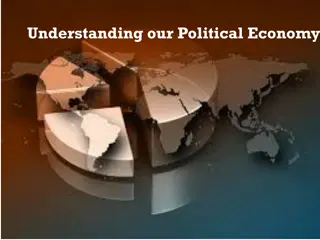Exploring the Relationship Between Technology and Society through Historical Perspectives
This collection delves into the complex interplay between technology and society, contrasting the deterministic view with the idea of reciprocal shaping. It examines various epochs from pre-modernity to the information age, highlighting how technology has influenced cultural shifts and modernity itself. Through discussions on the web, modernity, and the renaissance, it elucidates how technology and society have evolved together over time.
Download Presentation

Please find below an Image/Link to download the presentation.
The content on the website is provided AS IS for your information and personal use only. It may not be sold, licensed, or shared on other websites without obtaining consent from the author.If you encounter any issues during the download, it is possible that the publisher has removed the file from their server.
You are allowed to download the files provided on this website for personal or commercial use, subject to the condition that they are used lawfully. All files are the property of their respective owners.
The content on the website is provided AS IS for your information and personal use only. It may not be sold, licensed, or shared on other websites without obtaining consent from the author.
E N D
Presentation Transcript
Technological determinism the web as the product or outcome of scientific advances technology (e.g. the web) as a thing (a process of reification) with effects on society. Resource: Tim Berners-Lee inventor of the web http://www.ted.com/index.ph p/talks/tim_berners_lee_on_t he_next_web.html 1
A counter view: social shaping the relationship between science and technology is far more messy, contingent and complex. technologies do not have an essence (they are not a thing , they are not fixed) our relationship with technologies is reciprocal (we shape the web and the web shapes us). 2
Todays lecture Thinking about technology and modernity ( for the first time?) 3
Pre-modern Modernity Post modernity
Pre-modern Traditional (agrarian/feudal) Pre-ordained position Natural (Divine) law Natural and man- made are the same
Modernity Capitalist (industrial) Social order (division of labour) is socially created Nature/society and nature/science are distinct
Technology and modernity Technology made modernity possible Modernity and technology = tangled Reference: Misa T, Brey P, Feenberg A. (eds) Modernity and Technology. MIT Press, 2003 Information society is the product of information technology
Modernity cultural shift Art (reject realism) Architecture (e.g. Le Corbusier) Production (e.g. model T)
Renaissance C12th (medieval renaissance) C15/16th bridge to modernity Humanism (resurgence of the classics, rhetoric, dissemination, political citizenry) Art (da Vinci, Michelangelo perspective & light) Science (reason and evidence, questioning) Religion (reformation, challenge to Catholicism) Technology (windmills, spinning wheels, Arabic numbers)
Enlightenment C18th: philosophy, maths (Spinoza, Locke, Newton ) emancipation from ignorance (Kant) Emergence of civil society/public sphere Democracy (equality, freedom) Literacy (debate, critique and discussion) Question religious/monarchical authority Reason / science & rationality progress / Industrial revolution
Industrial revolution Mechanisation Technologies (e.g. textile, mining, steam engine) Population growth Urbanisation Productivity increases -> Trade expansion
Scientific attitude Direct observation (empiricism) Demarcation (break with natural law, testing) Reject idealism (Plato) and essentialism (Aristotle) Causality (laws) Idea of progress
Impact Economic complexity/inter-related institutions and phenomena Rise of democracy and nation state We can transform the world (science is central to this)
Theorising modernity Modernity as a way of organising social life Weber (rationalisation) Marx (changed economic structure new productive power relations - capitalism) Giddens (dynamism and globalisation) Beck (reflexive dealing with risk) Castells (networked society)
Weber Rationalisation is the key to modernity Technological standardization of knowledge and production Rational calculation (e.g. of profit) Administrative order (bureaucracy, division of labour) Modernity as liberating (progress, reason, freedom) but also the iron cage of modern bureaucratic organizational forms
Marx Shared Weber s view of rationalisation and technological progress The hand-mill gives you society with the feudal lord; the steam-mill society with the industrial capitalist. (1847) but also saw the dark side to modernity - technological and market alienation (in labour process and from the result/product of labour) the culture of the working class produced by technology
Giddens Modernity resting on 4 institutions: industrialism, capitalism, surveillance, military. Key features Separation of time and space, Dis-embedding of social life (e.g. timetables, money) Reflexive appropriation of knowledge
Beck simple modernization = the transformation of agrarian society into industrial society. (late) modernity = reflexive modernization - modern society confronts itself with the negative consequences of simple modernization; less about distribution of goods more about distribution of risks.
Castells information age = economic organization via the network (subjects and organizations) continually modified and adapting to (market) environments opposition (and new forms of social struggle) between the Net (abstract universalism of global networks) and the Self (strategies for people to affirm their identities)
Studies of the history of technology Focus on how a technology (e.g. PC) evolved and reflects the contexts in which it is developed/used. Often Time specific (e.g. focus on a particular development stage) Space specific (e.g. in a geographical area). Look at organizational, policy, and legal context actors, groups, organizations (e.g. engineers, industry, govt) discourses behaviours
Social Studies of Technology Focus on context in which technologies are developed (e.g. laboratory life) Both SST and historically focussed perspectives assume that technology is socially shaped But society also shaped by technology
Technology Modernity Technology as the driver of modernity Institutions and culture of modernity are not just shaped or influenced by technology, they are also constituted by it. BUT technology is seldom discussed/central in theories of modernity.
Why is this ? Technology as background (as catalyst or means by which modern institution operates (e.g. military) ; Is un(der)specified and vague; it s part of phenomena under study (e.g. for Weber it s is part of rationalisation, for Marx it enables new productive forces) but not discussed in detail Essentialism & reification - technology has fixed, context- independent properties that apply to all technologies; autonomous force.
Using modernism and post modernism to understand computer technologies Sherry Turkle (1995) Life on the Screen: Identity in the Age of the Internet - Explores rival computer design in mid- 1990s IBM-DOS PC users = modernist : wanted detailed understanding and control over (by typing inscrutable computer codes at the command line ) and liked operational transparency and conceptual openness. Apple Mac users used postmodernist images to describe their relationship to their machines - factory sealed beige boxes (+ a special factory tool to open them) which discouraged reductive understanding and detailed control. They surfed the conceptual surface of their machines with mouse clicks, windows, and icons.
Surveillance in modern society Lyon D. (2003) in Misa et al (eds) Modernity & Technology. Modernity characterised by surveillance (practices and technologies) technological developments: information infrastructures (surveillance networks) trigger surveillance (e.g. cross checking, verification) proliferation of surveillance data flows between networks surveillance practices (e.g. police broker information for insurers industry) to manage risks (e.g. predict terrorism) mutual shaping / amplified modernity via digital technology and consumerism -> postmodernity)
Miller D, Slater D (2000) The Internet: An Ethnographic Approach. Oxford: Berg ethnographic study of fast adoption of internet in Trinidad demonstrates that the concepts of "modernity" and "technology" are context-dependent rather than global "the context of a technology is also partly a consequence of that technology
Technologies interact deeply with society and culture, but the interactions involve mutual influence, substantial uncertainty, and historical ambiguity, eliciting resistance, accommodation, acceptance, and even enthusiasm. In an effort to capture these fluid relations, we adopt the notion of co-construction. Misa TJ. Modernity and Technology. 2003:3























